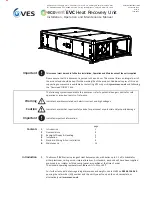
MAINTENANCE
9 EN
EN
properly and comfortably selection of "four stroke" mode is recom-
mended.
2.
Pedal-Operated Remote Control:
this mode is especially useful in combination with
pedals equipped with a microswitch with a trigger
function. This selection involves inhibition of the up
and down slopes. Welding current can be adjusted
with the pedal between the minimum value and the
panel setting.
The microswitch in the control pedal means you can start welding
by simply pressing the pedal, i.e. without using the TIG torch but-
ton. To use this peripheral device properly and comfortably selec-
tion of "four stroke" mode is recommended.
NOTE: IN THIS MODE, WHEN THE WELDING PROCESS IS
NOT ACTIVE, USING THE REMOTE CONTROL (PEDAL) WILL
PRODUCE NO CHANGE IN THE CURRENT INDICATED ON
THE DISPLAY.
10.0
MAINTENANCE
IMPORTANT: DISCONNECT THE POWER PLUG AND WAIT
AT LEAST 5 MINUTES BEFORE CARRYING OUT ANY MAIN-
TENANCE. MAINTENANCE MUST BE CARRIED OUT MORE
FREQUENTLY IN HEAVY OPERATING CONDITIONS.
Carry out the following operations every three (3) months:
- Replace any illegible labels.
- Clean and tighten the welding terminals.
- Replace damaged gas tubing.
- Repair or replace damaged welding cables.
- Have specialized personnel replace the power cable if dam-
aged.
Carry out the following operations every six (6) months:
- Remove any dust inside the generator using a jet of dry air.
- Carry out this operation more frequently when working in
very dusty places.
10.1
TYPES OF MALFUNCTIONING/WELDING FAULTS –
CAUSES – REMEDIES
TYPES OF MALFUNCTIONING
WELDING FAULTS
POSSIBLE CAUSES
CONTROLS AND REMEDIES
The generator does not weld: the digital switch
is not lit.
A) The main switch is off.
B) The power lead is interrupted (lack of one or
two phases).
C) Other.
A) Switch on mains.
B) Verify and repair.
C) Ask for the intervention of the Assistance Centre.
During welding suddenly the outgoing current is
interrupted, the the orange led goes on.
Overheating has occurred and the automatic
protection has come on. (See work cycles).
Keep generator switched on and wait till temperature
has dropped again (10-15 minutes) to the point where
the orange switch goes off again.
Welding power reduced.
Outgoing wires are not correctly attached.
A phase is missing.
Check that wires are intact, that the pliers are suffi-
cient and that they are applied to welding surface
clean from rust, paint or oils.
Excessive jets.
Welding arch too long.
Welding current too high.
Wrong torch polarity, lower the current values.
Craters.
Fast removal of the electrodes.
Inclusions.
Inadequate cleaning and bad distribution of
coating.
Faulty movement of the electrodes.
Inadequate penetration.
Forward speed too high. Welding current too
low.
Sticking.
Welding arch too short.
Current too low.
Increase current values.
Blowing and porosity.
Damp electrodes. Arch too long. Wrong torch
polarity.
Jacks.
Currents too high. Dirty materials.
The electrode fuses in TIG.
Wrong torch polarity. Type of gas not suitable.











































